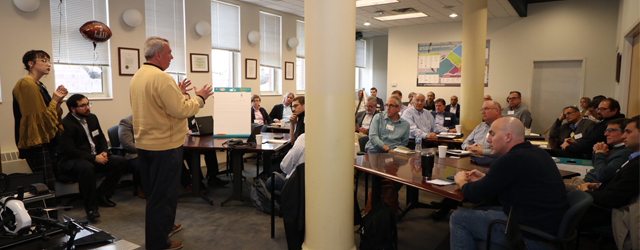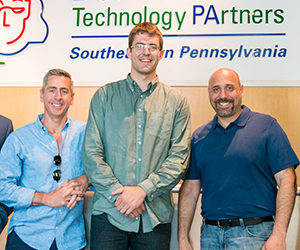Assembling an Ecosystem with the Robotics, UAV, & Drone Community
The robotics, unmanned aerial vehicle (UAV), and drone industries are growing in the region. Last year the Philadelphia Inquirer announced the city as the “robotics hub of the East Coast,” and while the announcement seemed gratuitous to some, evidence supports Philadelphia’s ability to become that hub and more. Local universities are a huge resource of talent and research. The University of Pennsylvania, for example, has brought us places like Penn Engineering Research and Collaboration Hub (PERCH), housed within the Penn Center for Innovation, and General Robotics Automation Sensing and Perception (GRASP) Lab, which explores robotics, embedded systems, systems engineering, computer and information science, and mechanical engineering and applied mechanics. Outside of the universities, organizations like Qualcomm Research Philadelphia have a growing team of engineers and researchers dedicated to developing, researching, and commercializing aerial vehicles and robotics systems. The number of companies working in these areas continues to grow. Within the Ben Franklin Technology Partners portfolio we have Telefactor Robotics, Asylon, and Rajant Corporation, to name a few.
As industry support and awareness expands, connecting these communities is increasingly important. So, how do you combat community fragmentation? It’s a question that haunts every community and industry, but has particular relevance in Philadelphia, where territory often defines our silos and knowledge of resources.
Step one?–you might ask–convening the current community of local innovators and combating the immediate sense of community fragmentation shared among them. Ben Franklin’s Director of Investments, Physical Sciences, Mark de Grandpre recently asked this question to a group from the robotics, UAV, and drone industries in the first installation of Industry Chat, an event dedicated to convening communities. The answer: community fragmentation is often a product of a problem and informed by an underlying condition opposed to being the sole obstacle. To generate a sense of community, the group must exist and be knowledgeable of the ways in which it exists.
Sounds complicated, but community has a lot of working parts and challenges. One of the event’s attendees said it best, “Everyone out there participating in these industries is keeping their heads down and that’s a problem. Job forums, knowing where to find people to fill vacancies at your company, and autonomy focused investors are a part of what helps a community like this keep and build momentum.” Resources for capital, rapid prototyping, and so much more are the bricks that build a sturdy foundation, and connectivity places those bricks on the same lot.
But let’s not get ahead of ourselves. Like all problems facing a community it is the community who should be informing them and outlining solutions. Prior to having the event, we invited the group to spell out potential obstacles facing their community, and the consensus was clear: talent attraction and regional retention, cost-effective manufacturing, and regulatory development stood in the path of security and support. And while every industry faces its own unique set of challenges, we are doing a deeper dive into those facing the local robotics, UAV, and drone industries, while proposing solutions.
Finding and Keeping Talent
Now, to be clear, the region has a robust set of folks working in the robotics, UAV, and drone industries. From engineers and entrepreneurs creating things like automated battery swap stations for drones, kinetic mesh, and a robot cart that follows you around, to professors shaping the minds of tomorrow’s innovators. The region has strong manufacturers and incredible access to markets outside of the region. In every way, this community is poised for success, but the conversation persists. In the wake of the Amazon bid, the region has plenty of resources to reference about how great we are, but taking that motivation and turning it into support for talent attraction and retention is a lot easier said than done.
“We need to consider awareness at local universities,” one of the event attendees pointed out, “More so, we need to find a way to better acquaint companies to the universities and introduce them as a resource. We have a couple of companies that are transplants to this area and they have yet to connect with sources of talent.” Hiring local is good for both companies and students, and contributes greatly to the region’s overall economic success. Keeping graduates in the region is something we are getting better at. Last summer, Campus Philly published a report that showed 67% of current students, out of a sample of 1,000 students, thought they would stay in Philadelphia for at least some period of time post-graduation. As Fabiola Cineas reported in Philadelphia Magazine, “When it comes to entering Philly’s workforce, about 88 percent think there are many (46 percent) or some (42 percent) job opportunities for them in Greater Philadelphia. And about 52 percent of seniors feel they have better job opportunities in Greater Philadelphia than elsewhere.” Connecting those who want to stay here with the right job opportunities will maintain and grow the number of post-graduates staying in Philadelphia, while securing future pipeline.
The time is now to capitalize on the pool of talent we have. Local companies have the opportunity to get more involved with universities by sponsoring events like hackathons, robotics competition teams, and by using partnership as a recruiting tool.
Getting Things Made
Speed to market, rapid prototyping, gauging product numbers, and finding cost effective solutions for your product creation are considerations and concerns when it comes to making it to market. Without these considerations one might fail. A question that came up within the discussion is, whether or not the region has enough manufactures.
Luckily there were representatives from DVIRC, an economic development organization dedicated to the region’s manufacturing community, and NextFab, a local makerspace, to provide a resounding yes. Yet connecting small startups with solutions based on their manufacturing needs, or getting them to a place where they have manufacturing needs, requires funding support.
Rectifying how connections between resources and capital are being networked will be a key factor of getting the right regional partners together. While creating locally is always a benefit—developing face-to-face relationships is helpful—but it’s not always the right move. Within this discussion comes the need to define the terms of local or regional, and to rethink the current parameters to better speak to the narrative of success in present focus.
Regulatory Development
How can you be proactive when what you are allowed to do is decided by those outside of your immediate scope, namely legislators and politicians? This is a huge hurdle for those working with drones, however this is an issue that isn’t exclusive to our region, and has made successful head-way in others.
This is where the regional focus betrays us a bit—we don’t always have to recreate the wheel. Focusing on those who have made regulatory progress, and bringing them into the conversation, is pivotal in generating progress.
There is also a case to be made against other companies who may have a regulatory advantage. Another event attendee had this to say about that very circumstance: ”Say you’re a small company with some nice technology, some big incumbent has some regulatory advantage, so how do you overcome that? From my past experience in industrial vehicles, I’ve coined a three pronged approach to get around it: one, have a better value proposition over the current thing that is in place; two, actually have stuff that works. Don’t have a written document or go lobbying, actually make the thing and show that it works; three, build strong partnerships. As Kevin O’Leary would say, ‘You are likely just a cockroach,’ go partner with someone big and let them make the case to help put you in front of the right people.”
Attracting Customers
This was considered the chicken or the egg problem for the robotics, UAV, and drone community, but ultimately they saw a huge opportunity for partnership here as well. In many cases, attracting customers means making customers. Sounds counter-intuitive, but if you are personally seeking to integrate what may be perceived as a new technology, you are going to have to make the case for it, and potentially make a customer out of someone who may not inherently have thought of themselves as a potential customer.
There’s a strong opportunity to work with our local government, for example. A case can be made for relevant collaboration that meets civic needs but also embraces innovation. Trash collection, meter scanners, etc. can all be made more effective and efficient by embracing technology. City government isn’t the only place collaboration can happen, local institutions both corporate and public, can look to the community to solve relevant organizational issues, but like the end of a date, who fits the bill comes into question. Capital is going to drive many partnerships (hence the chicken or the egg problem), so figuring out where those dollar bills are coming from early on is fundamental.





